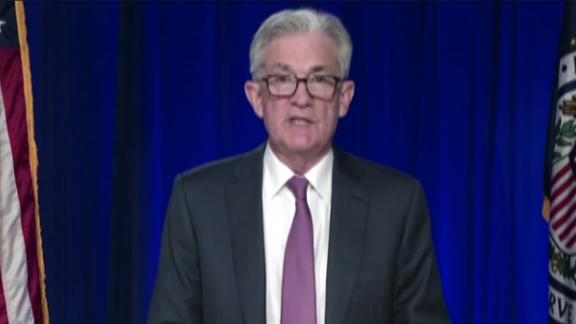The Fed keeps rates near zero and acknowledges fragile recovery

The Federal Reserve, as widely expected, left its key short-term interest rate near zero following its latest policy meeting Wednesday. The Fed cut rates to that level in March and has maintained that they are likely to remain there for several years as the economy recovers from the Covid-19 pandemic.
The Fed has launched several lending programs and other stimulus efforts in addition to slashing interest rates this year to support the economy during the coronavirus crisis.
But Fed chair Jerome Powell has continued to stress that the Fed (as well as Congress and the White House) may need to do more to help struggling American consumers and businesses.
“Economic activity and employment have continued to recover but remain well below their levels at the beginning of the year,” the Fed said in its statement.
“The path of the economy will depend significantly on the course of the virus. The ongoing public health crisis will continue to weigh on economic activity, employment, and inflation in the near term, and poses considerable risks to the economic outlook over the medium term,” the Fed added.
During a press conference, Powell noted that the optimism about Covid-19 vaccines is encouraging, but he noted it will take more time until Americans feel fully confident that they will be able to “reengage” in normal activities that would help boost the economy.
The central bank also released a separate survey of economic projections for the next few years.
The Fed does appear a little more optimistic about the future, indicating that it anticipates a 4.2% rebound in the nation’s gross domestic product in 2021 — up from a September forecast of 4% annualized growth.
The Fed also is forecasting that the unemployment rate will drop back to 5% by next year — down from an earlier estimate of 5.5%.
That’s still higher than where the unemployment rate was before the pandemic ramped up in the US in the spring. Powell pointed out in the press conference that the path of the overall economy remains “highly uncertain,” though he noted that the housing market has “fully recovered.”
“With vaccines on the horizon, the Fed’s economic projections for the next few years all got an upgrade, but don’t gloss over the immediate challenges still confronting the economy,” said Bankrate chief financial analyst Greg McBride in a report after the Fed announcement.
There are growing hopes that a new round of fiscal stimulus may be coming soon from politicians in Washington — and perhaps more will be done once President-elect Joe Biden takes office next month.
Recognizing the continued sluggishness of the broader economy, the Fed said in its statement that it plans to continue buying Treasury bonds and mortgage-backed securities as a way to help keep long-term bond rates low.
The Fed does not appear to be worried about all this stimulus leading to inflation.
“Weaker demand and earlier declines in oil prices have been holding down consumer price inflation,” the Fed said — helping to justify why it will not need to raise interest rates anytime soon. The Fed said it expects an inflation rate of just 1.8% next year and 1.9% in 2022.
Still, there are some concerns about inflation eventually roaring back with a vengeance due to the large amount of stimulus.
“The risk is that we see material inflation surprises ahead of schedule,” said Ed Al-Hussainy, senior interest rate and currency analyst at Columbia Threadneedle, in a report.
Powell also said during the press conference that the recent rise in housing prices is not of a concern from a financial stability standpoint. He thinks it is a reflection of pent-up demand.
But Robert Frick, corporate economist with Navy Federal Credit Union, said in a tweet that he’s worried the Fed’s bond buying is keeping long-term rates low — and that “is making mortgage prices extremely cheap, and that’s fueling the bubble as much as demand.”
President-elect Biden will need to decide sometime in 2021 whether or not he wants to keep Powell as head of the Fed or nominate someone else to lead the central bank.
Powell’s term ends in February 2022 and there has been speculation that current Fed governor Lael Brainard, who was rumored to be a Treasury Secretary candidate before Biden selected Powell’s Fed predecessor Janet Yellen, could one day succeed Powell.
Roger Ferguson, a former Fed vice chairman who recently announced plans to retire as CEO of investing firm TIAA, could also be a contender to take over the Fed. Ferguson would make history as the Fed’s first Black chairman.
